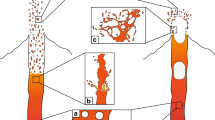Abstract
Fragmentation of magma containing gas bubbles is of great interest in connection with developing models for the formation of pyroclastics and for volcanic blasts (explosions). This paper considers the problem of fragmentation of highly viscous (η>108 Pa s) or solidified magma containing bubbles with excess gas pressure. It is suggested that the fragmentation of magma be considered on the basis of the fragmentation wave theory proposed by Nikolsky and Khristianovich, which is generally applicable to gas-dynamic phenomena occurring in mines. Then it becomes possible to derive the equations of conservation for the fragmentation wave front which moves into a body of magma from its free surface. As a result, the velocity, N, of magma fragmentation, and the velocity, u, of the movement of the gas-pyroclastic mixture behind the fragmentation wave front, are determined. Calculations show that N can reach ∼5 m/s. Therefore the duration of the fragmentation of the magma body (blast duration) proves to be long. The suggested model explains the possibility of several explosions during the blast as a result of the fragmentation wave stopping, and accounts for the angular shape of pyroclasts by the brittle disruption of interbubble partitions during fragmentation wave propagation through the porous magma body. The initiation and cessation of fragmentation are defined by magma porosity, magma tensile strength, and the pressure differential between gas pressure in pores and the atmospheric pressure. The physical model of magma fragmentation developed explains the mechanism of energy release during volcanic blasts of the Vulcanian or Pelean types.
Similar content being viewed by others
References
Bennett FD (1974) On volcanic ash formation. Am J Sci 274:648–661
Bogoyavlenskaya GE, Braitseva OA, Melekestsev IV, Kiriyanov VY, Miller CD (1985) Catastrophic eruptions of the directed-blast type at Mount St. Helens, Bezymianny and Shiveluch volcanoes. J Geodynam 3:189–218
Carey S, Sigurdsson H (1985) The May 18, 1980, eruption of Mount St. Helens. 2. Modelling of dynamics of the plinian phase. J Geophys Res 90:2948–2958
Eichelberger JC, Hayes DB (1982) Magmatic model for the Mount St. Helens blast of May 18, 1980. J Geophys Res 87:7727–7738
Gelfand BE, Gubanov AV, Medvedev SP, Timofeev EI, Tsyganov SA (1985) Shock waves during expansion of the compressed gas volume containing solid particles. Doklady AN SSSR 281:1113–1116 (in Russian)
Gorshkov GS, Bogoyavlenskaya GE (1965) The Bezymianny volcano and features of its last eruption. Nauka, Moscow, pp 1–172 (in Russian)
Ivandaev AI (1984) The flow with particles in the shock tube. Phys Goreniya Vzryva 20:105–111 (in Russian)
Ivanov AG, Mineev VN (1979) On the scale effects during disruptions. Phys Goreniya Vzryva 15:70–95 (in Russian)
Khristianovich SA (1953) On the outburst wave. On the crush wave. Izvest Acad Nauk SSR, OTN 12:1679–1699 (in Russian)
Khristianovich SA (1979) Unrestricted flow of soil mass caused by the expansion of the high-pressure gas contained in pores. The crush wave. Preprint 128, Inst Probl Mechan AN SSSR, Moscow, pp 1–61 (in Russian)
Kieffer SW, Sturtevant B (1984) Laboratory studies of volcanic jets. J Geophys Res 89:8253–8268
Kovalev GN, Samoilenko BI, Storcheus AV (1980) On the nature of volcanic explosions of the Grate Tolbachik fissure eruption. Volcanol Seismol 3:62–71 (in Russian)
Kurlaev AR (1980) Estimation of the effect of degassing of the unrestricted flow of soil mass containing the compressed gas in pores. Preprint 163, Inst Probl Mechan AN SSSR, Moscow, pp 1–33 (in Russian)
Landau LD, Lifshits EM (1965) The theory of elasticity. Nauka, Moscow, pp 1–204 (in Russian)
McBirney AR, Murase T (1970) Factors governing the formation of pyrocastic rocks. Bull Volcanol 34:372–384
Nikolski AA (1953) On the disruption waves of aerated rocks. Doklady AN SSSR 91:1035–1038 (in Russian)
Self S, Wilson L, Nairn IA (1979) Vulcanian eruption mechanisms. Nature 277:440–443
Slezin YB (1979) The condition of the dispersive flow occurrence during an explosive volcanic activity. Volcanol Seismol 3:69–76 (in Russian)
Sparks RSJ (1978) The dynamics of bubble formation and growth in magmas: a review and analysis. J Volcanol Geotherm Res 3:1–37
Wilson L (1980) Relationships between pressure, volatile content and ejecta velocity in three types of eruptions. J Volcanol Geotherm Res 8:297–313
Wilson L, Sparks RSJ, Walker GPL (1980) Explosive volcanic eruptions. IV The control of magma properties and conduit geometry on eruption column behavior. Geophys J Roy Astron Soc 63:117–148
Wohletz KH (1983) Mechanics of hydrovolcanic pyroclast formation: grain size, scanning electron microscopy and experimental studies. J Volcanol Geotherm Res 17:31–63
Wohletz KH, McGetchin TR, Sandford II MT, Jones EM (1984) Hydrodynamic aspects of caldera-forming eruptions: numerical models. J Geophys Res 89:8269–8285
Author information
Authors and Affiliations
Rights and permissions
About this article
Cite this article
Alidibirov, M.A. A model for viscous magma fragmentation during volcanic blasts. Bull Volcanol 56, 459–465 (1994). https://doi.org/10.1007/BF00302827
Received:
Accepted:
Issue Date:
DOI: https://doi.org/10.1007/BF00302827




